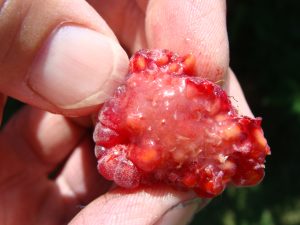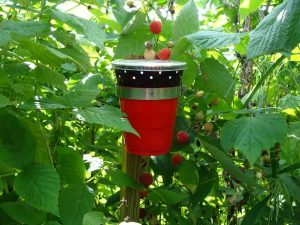Spotted Wing Drosophila Alert: July 20, 2020
SPOTTED WING DROSOPHILA ALERT: JULY 20, 2020
Click on photos to enlarge.
David Handley, Vegetable and Small Fruit Specialist; James Dill, Pest Management Specialist

We have found spotted wing drosophila (SWD) fruit flies in raspberry plantings and late strawberry beds in Maine over the past week in southern Maine locations. This complements reports from other New England states indicating that SWD is active and in high numbers early this season.
The fly counts this week are at relatively low levels and not yet above what are considered potentially damaging to ripening berry crops, especially raspberries and blueberries. Research suggests that when six to ten flies are caught in a yeast-baited trap in a week, larvae will start appearing in the fruit.
Spotted wing drosophila populations are likely to build rapidly in the coming weeks as more food (fruit) becomes available for the flies, especially if conditions remain warm and we get some rain. Now is the time to set out traps, if you haven’t already. Start protective sprays on any berries that have begun to ripen, when more than four spotted wing drosophila flies are caught in a trap, or any larvae are noticed in the fruit. Look for fruit flies hovering around fruit and symptoms of premature fruit decay.
Research has shown that dry conditions and exposure reduce the number of eggs these insects will lay in the fruit. This supports recommendations to open up your berry plantings by pruning, especially low growth, as these insects favor dark, moist conditions, close to the ground.

Important Points for Managing Spotted Wing Drosophila Include:
- Monitor for the flies with traps, and for the larvae in fruit.
- Spray regularly and often once flies or larvae have been found in the field (every five to seven days).
- Harvest fruit regularly and often; do not leave any ripe/rotten fruit in the field.
- Sort fruit at harvest; do not leave any soft fruit in the container to be sold.
- Chill all fruit immediately after harvest to 38ºF (or as close as you can) for at least 12 hours to slow or stop development of any eggs or larvae.
- Prune the planting, especially the lower region, to open up the canopy and create dry, light conditions.
Products that provide good control of drosophila on berry crops include spinosad (Radiant® for strawberries, Delegate® for raspberries and blueberries), Asana®, Brigade®, Danitol®, malathion, Exirel® (blueberries only) and Assail®. Research suggests that adding table sugar to group 4A insecticides, such as Assail®, may improve their effectiveness. The recommended rate would be 1-2 lbs. sugar per 100 gallons of spray. Also, it is recommended to add 4-16 oz Nu Film P®/100 gal with all materials to improve SWD efficacy and, if it rains after you spray, re-apply a pesticide material. (Read the label for any re-application restrictions of the same material.) Please check product labels for rates, post-harvest intervals and safety precautions.
A list (courtesy of Mary Concklin at UConn Extension) of labeled spray materials for SWD can be found here: PDF of 2018 SWD Insecticides.
| Trade Name | Days to Harvest Blueberry |
Days of Residual |
|---|---|---|
| Assail® | 1 | 5-7 |
| Mustang Max® | 1 | 7 |
| Bifenture® | 1 (3 raspberry) | 7 |
| Brigade® | 1 (3 raspberry) | 7 |
| Danitol® | 3 | 7 |
| Delegate® | 3 (1 raspberry) | 7 |
| Entrust® | 3 (1 raspberry) | 3-5 |
| Exirel® | 3 (1 raspberry) | 5-7 |
| Imidan® | 3 (not for raspberry) | 5-7 |
A Simple Monitoring Trap for Spotted Wing Drosophila:
The trap body is made from a 16-ounce red plastic cup (we use Solo Brand P16RLR). You’ll need one that has a tight-fitting lid (we use Solo Brand 626TS). Using a 1/8” hole punch (available through art suppliers), punch about 15 holes in a row around the cup just under the lip about 1/2” apart. Leave about 2” of the diameter of the rim with no holes so that liquid can be poured in and out. Punch a second row of holes just under the first row, to give you a total of 30, 1/8” holes. Use a black permanent marker to paint a 1/2” wide black strip around the cup under the rim, right over the holes you punched. To support the trap, cut a wooden tomato stake down to about 30”. Attach a 4” or larger hose clamp near the top of the stake to act as a cup holder for the trap. (We just punched a hole in the metal band of the hose clamp and attached it to the stake with a flat-headed wood screw.) Place the trap holder in a shady, moist place in or near the fruit planting, with the cup height 12” to 18” off the ground. Fill the trap with 4 to 6 ounces of apple cider vinegar, water + sugar + yeast, or whatever bait you prefer. It is best to add a few drops of unscented soap to break the surface tension of the liquid. Place the lid on the cup to keep rain and critters from getting in, and place the trap in the holder. Adjust the hose clamp so that the trap fits in snugly but the trap holes are not covered up. Empty and re-bait the trap every week. Do not pour out the old bait on the ground near the trap, as this will draw flies away from it. Check the traps and change the bait at least weekly.
An effective commercial trap and bait is now available from Scentry. The trap is reusable and the bait lasts 4-6weeks. Cost for both is about $15 plus shipping, it is available from Great Lakes IPM Company
For more information on identifying spotted wing drosophila (SWD) and updates on populations around the state, visit our SWD blog
Other IPM Web Pages
Michigan State University
David T. Handley
Vegetable and Small Fruit Specialist
Highmoor Farm Pest Management Unit
P.O. Box 179 17 Godfrey Drive
Monmouth, ME 04259 Orono, ME 04473
207.933.2100 1.800.287.0279
Where brand names or company names are used it is for the reader’s information. No endorsement is implied nor is any discrimination intended against other products with similar ingredients. Always consult product labels for rates, application instructions and safety precautions. Users of these products assume all associated risks.
The University of Maine is an equal opportunity/affirmative action institution.
